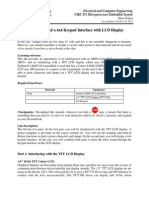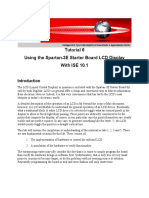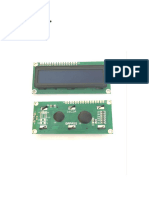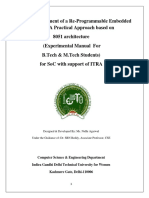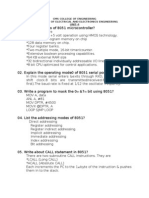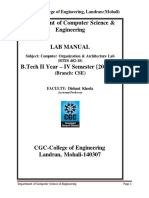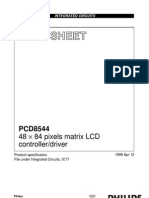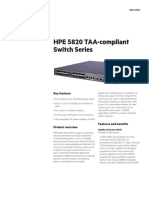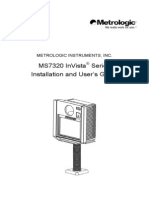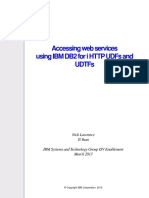Lab 11: Liquid Crystal Display
Lab 11: Liquid Crystal Display
Uploaded by
JamesSmith2014Original Title
Copyright
Available Formats
Share this document
Did you find this document useful?
Is this content inappropriate?
Report this DocumentCopyright:
Available Formats
Lab 11: Liquid Crystal Display
Lab 11: Liquid Crystal Display
Uploaded by
JamesSmith2014Copyright:
Available Formats
Module 11
Lab 11: Liquid Crystal Display
Lab: Liquid Crystal Display
11.0 Objectives 11.1.4 Components needed for this lab
The purpose of this lab is to interface an LCD display to the microcontroller and
develop a set of software routines to assist in debugging subsequent labs on the
Quantity Description Manufacturer Mfg P/N
robot.
1. You will connect an LCD to the microcontroller.
2. You will use the synchronous serial protocol to communicate.
3. You will implement a set of software functions for the LCD. MSP-
1 EXP432P401R TI MSP-EXP432P401R
LaunchPad
Good to Know: Even though the LCD doesn’t actually contribute to the input-
calculate-output loop required to solve the robot challenge, it will be extremely
useful when debugging when the robot is running untethered in the arena.
1 LCD display Nokia 5110
11.1 Getting Started
11.1.1 Software Starter Projects
Look at this project: 11.1.5 Lab equipment needed
Lab11_FSM (starter project for this lab) Oscilloscope (two channels with at least 10MHz sampling)
Or Logic Analyzer (4 channels with at least 10MHz sampling)
11.1.2 Student Resources (in datasheets directory)
Nokia5110.pdf (data sheet for the LCD) 11.2 System Design Requirements
The overall goal of this lab is to interface an LCD to the microcontroller and
use it to output characters and numbers. The Nokia 5110 is a monochrome
11.1.3 Reading Materials display that is 84 pixels wide by 48 pixels high. Each character is defined by a
Volume 1 Sections 4.5, 7.6, 7.7, 8.3, and 8.4 5 pixels wide by 8 pixels high image. You can see the font table as a constant
Embedded Systems: Introduction to the MSP432 Microcontroller", array called ASCII inside Nokia.c starter file. For example, the letter ‘7’ is defined
or in line 132 as
Volume 2 Sections 1.5, 3.4, and 7.5
Embedded Systems: Real-Time Interfacing to the MSP432 Microcontroller", {0x01, 0x71, 0x09, 0x05, 0x03}
This 40-bit value creates the image shown in Figure 1 on the display. The 0x01 is
the first column and 0x03 is the last column, with bit 0 on top.
Each character has bit 7 clear to make a space between lines. The function
Nokia5110_OutChar will place a blank vertical line in front of and one blank line
after each character. This means each character requires a 7 by 8 pixel area to
print. Since the display is 84 wide by 48 high, this font size allows for 84/7= 12
characters on each line, and allows 48/8=6 lines.
Figure 1. Bump sensors positioned at the front of the robot.
2 Texas Instruments Robotics System Learning Kit: The Maze Edition
SWRP182
Lab: Liquid Crystal Display
Bit 0
Bit 1
Bit 2
Bit 3
Bit 4
Bit 5
Figure 2. Five pins on Port 9 can be used to interface the LCD.
Bit 6
Bit 7
Figure 1. Pixel image to create the number 7, showing a blank vertical line before
and after the character. Bit 7 is clear for all characters. 11.4 System Development Plan
On the low level, you are required to write one routine that sends an 8-bit 11.4.1 lcdcommandwrite
command to the LCD (lcdcommandwrite) and a second routine that sends 8-bit
data to the LCD (lcddatawrite). These routines use busy-wait synchronization
To send one 8-bit command, your lcdcommandwrite function should perform
with the SPI synchronous serial interface. These are private functions, so
the following four steps, even though 1) and 4) are the same.
prototypes are not available in the Nokia5110.h header file.
On the high level, you are required to write one routine that outputs a string 1) Wait for the SPI to be idle (let previous frame finish), UCBUSY
(Nokia5110_OutString) and a second routine to output an unsigned 16-bit 2) Set DC for command (0)
decimal number (Nokia5110_OutUDec). 3) Write 8-bit command to the SPI data register (TXBUF), starts SPI
4) Wait for the SPI to be idle (let this transmission finish), UCBUSY
You will find the Nokia5110.h and Nokia5110.c files in the inc folder. This
means after you complete this lab, you can use these functions in the remaining Look up in the Nokia5110 and MSP432 data sheets what the expected
labs. waveforms should look like when lcdcommandwrite is called in the program.
Use an oscilloscope or logic analyzer to verify the waveforms are as expected.
11.3 Experiment set-up You can use a simple program like the following to test this low-level function.
You will implement this lab using the MSP432 LaunchPad and the LCD. Figure 2 void Testlcdcommandwrite(void){
shows Port 9 can be used to interface the LCD. However you may use any pins while(1){
that support the synchronous serial port (SPI protocol). Pins P9.7, P9.5, and P9.4 lcdcommandwrite(0x21);
are configured for SPI mode. Pins P9.3 and P9.6 are set to be regular digital }
outputs. DC=1 means data, and DC=0 means command. The reset pin is used to }
initialize the LCD hardware (RESET=0, at least 100ns wait, RESET=1).
3 Texas Instruments Robotics System Learning Kit: The Maze Edition
SWRP182
Lab: Liquid Crystal Display
11.4.2 lcddatawrite
Nokia5110_SetCursor(3,2); // spot for number
To send one 8-bit data, your lcddatawrite function should perform the following Nokia5110_OutUDec(myDistance);
three steps. Skipping step 4) when outputting data makes it run much faster.
Use a debugging profile to measure how long it takes to execute
1) Wait for the SPI to be idle (let previous frame finish), UCBUSY Nokia5110_OutUDec. Knowing that the 12 MHz SPI clock is 12 MHz, explain
2) Set DC for data (1) why this measurement is reasonable.
3) Write 8-bit data to the SPI data register (TXBUF), starts SPI
11.5 Troubleshooting
11.4.3 Nokia5110_OutString
The LCD does not display characters:
There is a midlevel function given to you called Nokia5110_OutChar that
outputs one character to the LCD. You will use this function to implement a • Check all the connections between LaunchPad and LCD.
function called Nokia5110_OutString that outputs a string to the LCD. • Make sure RESET is high.
• Run a simple main program that calls lcdcommandwrite over and over
11.4.4 Nokia5110_OutUDec with the same command. Use a logic analyzer or scope to verify all five
signals from LaunchPad to LCD are proper. Section 12.1 of the data
sheet describes the expected SPI protocol.
Similarly, you will use Nokia5110_OutChar to implement a function called
Nokia5110_OutUDec that outputs a 16-bit unsigned number to the LCD. One of
the specifications for this function is that the image is created right justified that Back light does not operate:
fills exactly 5 characters. This functionality allows you to output numbers on the
LCD that are easy to read. • Check the ground.
• Verify you have pin 1 properly identified and haven’t wired it backwards.
More specifically, for numbers 0 to 9, you will output 4 spaces and the one digit.
For numbers 10 to 99, you will output 3 spaces followed by two digits. For 11.6 Things to think about
numbers 100 to 999, you will output 2 spaces followed by three digits. For
numbers 1000 to 9999, you will output 1 space followed by four digits. For
numbers 10000 to 65535, you will output all five digits. In this section, we list thought questions to consider after completing this lab.
These questions are meant to test your understanding of the concepts in this lab.
To illustrate how this function could be used, consider the example where the
LCD contains debug data continuously updated during a robot run, You could • What does it mean that this interface is serial? Why is serial important?
execute this code once at the beginning • What does it mean that this interface is synchronous? Why is
synchronous important?
• What is the purpose of each of these three files: Nokia5110.h,
Nokia5110_SetCursor(0,2); // left, third row Nokia5110.c, and Lab11_LCDmain.c?
Nokia5110_OutString("D= "); • How long does it take to execute Nokia5110_OutUDec? Is it
Nokia5110_OutUDec(0); appropriate to call this function during an ISR, or is it better to always
Nokia5110_OutString(" mm"); perform LCD output in the main program?
Then, when you wish to update the LCD with a new distance value, you can just
output the 5 characters of the new value. This method will make a pretty display
that will not flicker as the numbers change.
4 Texas Instruments Robotics System Learning Kit: The Maze Edition
SWRP182
Lab: Liquid Crystal Display
11.7 Additional challenges 11.9 Things you should have learned
In this section, we list additional activities you could do to further explore the In this section, we review the important concepts you should have learned in this
concepts of this module. You could extend the system or propose something module:
completely different. For example,
• Understand busy-wait and know why busy-wait was used for this
• Add an output function for 16-bit signed numbers. interface and not interrupts
• Add an output function for signed 32-bit numbers • Synchronous serial protocol: how it works and why it is important
• Interface a different LCD, such as the ST7735R • The concept of minimally intrusive debugging
• Create a set of functions that plots data versus time on the LCD
11.8 Which modules are next?
Modules 1-11 have introduced the basics of the microcontroller. The next set of
modules allow for more complex functionality for the robot.
Module 12) interface the motors to the robot.
Module 13) write software to adjust power to the motors.
Module 14) use interrupts to detect collisions in real time
Module 15) interface IR distance sensors to measure distance to the wall.
Module 16) interface tachometers to measure wheel speed.
5 Texas Instruments Robotics System Learning Kit: The Maze Edition
SWRP182
IMPORTANT NOTICE FOR TI DESIGN INFORMATION AND RESOURCES
Texas Instruments Incorporated (‘TI”) technical, application or other design advice, services or information, including, but not limited to,
reference designs and materials relating to evaluation modules, (collectively, “TI Resources”) are intended to assist designers who are
developing applications that incorporate TI products; by downloading, accessing or using any particular TI Resource in any way, you
(individually or, if you are acting on behalf of a company, your company) agree to use it solely for this purpose and subject to the terms of
this Notice.
TI’s provision of TI Resources does not expand or otherwise alter TI’s applicable published warranties or warranty disclaimers for TI
products, and no additional obligations or liabilities arise from TI providing such TI Resources. TI reserves the right to make corrections,
enhancements, improvements and other changes to its TI Resources.
You understand and agree that you remain responsible for using your independent analysis, evaluation and judgment in designing your
applications and that you have full and exclusive responsibility to assure the safety of your applications and compliance of your applications
(and of all TI products used in or for your applications) with all applicable regulations, laws and other applicable requirements. You
represent that, with respect to your applications, you have all the necessary expertise to create and implement safeguards that (1)
anticipate dangerous consequences of failures, (2) monitor failures and their consequences, and (3) lessen the likelihood of failures that
might cause harm and take appropriate actions. You agree that prior to using or distributing any applications that include TI products, you
will thoroughly test such applications and the functionality of such TI products as used in such applications. TI has not conducted any
testing other than that specifically described in the published documentation for a particular TI Resource.
You are authorized to use, copy and modify any individual TI Resource only in connection with the development of applications that include
the TI product(s) identified in such TI Resource. NO OTHER LICENSE, EXPRESS OR IMPLIED, BY ESTOPPEL OR OTHERWISE TO
ANY OTHER TI INTELLECTUAL PROPERTY RIGHT, AND NO LICENSE TO ANY TECHNOLOGY OR INTELLECTUAL PROPERTY
RIGHT OF TI OR ANY THIRD PARTY IS GRANTED HEREIN, including but not limited to any patent right, copyright, mask work right, or
other intellectual property right relating to any combination, machine, or process in which TI products or services are used. Information
regarding or referencing third-party products or services does not constitute a license to use such products or services, or a warranty or
endorsement thereof. Use of TI Resources may require a license from a third party under the patents or other intellectual property of the
third party, or a license from TI under the patents or other intellectual property of TI.
TI RESOURCES ARE PROVIDED “AS IS” AND WITH ALL FAULTS. TI DISCLAIMS ALL OTHER WARRANTIES OR
REPRESENTATIONS, EXPRESS OR IMPLIED, REGARDING TI RESOURCES OR USE THEREOF, INCLUDING BUT NOT LIMITED TO
ACCURACY OR COMPLETENESS, TITLE, ANY EPIDEMIC FAILURE WARRANTY AND ANY IMPLIED WARRANTIES OF
MERCHANTABILITY, FITNESS FOR A PARTICULAR PURPOSE, AND NON-INFRINGEMENT OF ANY THIRD PARTY INTELLECTUAL
PROPERTY RIGHTS.
TI SHALL NOT BE LIABLE FOR AND SHALL NOT DEFEND OR INDEMNIFY YOU AGAINST ANY CLAIM, INCLUDING BUT NOT
LIMITED TO ANY INFRINGEMENT CLAIM THAT RELATES TO OR IS BASED ON ANY COMBINATION OF PRODUCTS EVEN IF
DESCRIBED IN TI RESOURCES OR OTHERWISE. IN NO EVENT SHALL TI BE LIABLE FOR ANY ACTUAL, DIRECT, SPECIAL,
COLLATERAL, INDIRECT, PUNITIVE, INCIDENTAL, CONSEQUENTIAL OR EXEMPLARY DAMAGES IN CONNECTION WITH OR
ARISING OUT OF TI RESOURCES OR USE THEREOF, AND REGARDLESS OF WHETHER TI HAS BEEN ADVISED OF THE
POSSIBILITY OF SUCH DAMAGES.
You agree to fully indemnify TI and its representatives against any damages, costs, losses, and/or liabilities arising out of your non-
compliance with the terms and provisions of this Notice.
This Notice applies to TI Resources. Additional terms apply to the use and purchase of certain types of materials, TI products and services.
These include; without limitation, TI’s standard terms for semiconductor products http://www.ti.com/sc/docs/stdterms.htm), evaluation
modules, and samples (http://www.ti.com/sc/docs/sampterms.htm).
Mailing Address: Texas Instruments, Post Office Box 655303, Dallas, Texas 75265
Copyright © 2018, Texas Instruments Incorporated
You might also like
- Nokia 5110 LCD Displays On The ATtinyDocument14 pagesNokia 5110 LCD Displays On The ATtinypolikarpaNo ratings yet
- 7 SegmentDocument14 pages7 SegmentTudor CiotloșNo ratings yet
- Encoder Reading Using LabVIEW and ArduinoDocument12 pagesEncoder Reading Using LabVIEW and ArduinoWaleed El-Badry100% (1)
- Nokia 6100 LCD Display Driver: Revision 1 Author: James P. LynchDocument55 pagesNokia 6100 LCD Display Driver: Revision 1 Author: James P. LynchJamesSmith2014No ratings yet
- Nokia 6100 LCD Display Driver: Revision 1 Author: James P. LynchDocument55 pagesNokia 6100 LCD Display Driver: Revision 1 Author: James P. LynchJamesSmith2014No ratings yet
- pcf7935 PPDocument6 pagespcf7935 PPovidfiuNo ratings yet
- EEE Question BankDocument7 pagesEEE Question Bankmokshamparekh2005No ratings yet
- Pic Based LockDocument5 pagesPic Based LockamshahidNo ratings yet
- Nokia 6100 LCD Display DriverDocument35 pagesNokia 6100 LCD Display DriverNikhil HandeNo ratings yet
- 8051 Second Programming ExcerciseDocument4 pages8051 Second Programming Excercisev.kinnarNo ratings yet
- Chapter 1: Introduction Chapter 2: Hardware RequiredDocument21 pagesChapter 1: Introduction Chapter 2: Hardware RequiredsahilNo ratings yet
- Lab 4 v1Document6 pagesLab 4 v1VoDanhQNo ratings yet
- 1,8 TFT Display ENDocument23 pages1,8 TFT Display ENwilsnicoNo ratings yet
- Lab 1Document13 pagesLab 1Sagar SinghNo ratings yet
- Microprocessor Model Paper 1Document4 pagesMicroprocessor Model Paper 1Kunal Dev KaushalNo ratings yet
- Nokia 6100 LCD Display DriverDocument55 pagesNokia 6100 LCD Display DriverHoang Manh NgocNo ratings yet
- 1.8inch LCD Module User Manual enDocument7 pages1.8inch LCD Module User Manual enAyush YadavNo ratings yet
- Tutorial 6 Using The Spartan-3E Starter Board LCD Display With ISE 10.1Document18 pagesTutorial 6 Using The Spartan-3E Starter Board LCD Display With ISE 10.1Jesus AvilaNo ratings yet
- Write A Program For Interfacing The 16x2 LCD MODULES AimDocument7 pagesWrite A Program For Interfacing The 16x2 LCD MODULES AimLeelasrikanth TubatiNo ratings yet
- LightShark v1 4 ENDocument182 pagesLightShark v1 4 ENAdán Iván López GarzaNo ratings yet
- Arduino LCD Set Up2Document10 pagesArduino LCD Set Up2Mikaela MosqueraNo ratings yet
- Lab 7Document6 pagesLab 7Minh NamNo ratings yet
- LCD InterfacingDocument4 pagesLCD InterfacingSavinda SenevirathneNo ratings yet
- Microprocessor Lab Manual - FinalDocument157 pagesMicroprocessor Lab Manual - FinalDr. N.Shanmugasundaram100% (6)
- Fpga: Digital Designs: Team Name:Digital DreamersDocument8 pagesFpga: Digital Designs: Team Name:Digital DreamersRishabhNo ratings yet
- Lab 1Document4 pagesLab 1sharmanator99No ratings yet
- 16x2 LCD ModuleDocument4 pages16x2 LCD Modulevinoth KumarNo ratings yet
- Digital Code Lock System - WWW - BooknstuffDocument10 pagesDigital Code Lock System - WWW - Booknstuffyampire100% (2)
- MC Lab Manual-2013Document76 pagesMC Lab Manual-2013saisuchandanNo ratings yet
- LAB Manual 8051Document60 pagesLAB Manual 8051Romeu Corradi JúniorNo ratings yet
- Hitachi HD44780 LCDDocument2 pagesHitachi HD44780 LCDDamodarBhatNo ratings yet
- Microprocessor Lab ManualDocument69 pagesMicroprocessor Lab ManualKrishnaveni DhulipalaNo ratings yet
- Report of Telephone Directory ProjectDocument20 pagesReport of Telephone Directory Projectsimorge86% (7)
- Lab Task 06 (Software Based Delay)Document4 pagesLab Task 06 (Software Based Delay)Michael SchofieldNo ratings yet
- Digita Ic Tester Using MicrocontrollerDocument21 pagesDigita Ic Tester Using MicrocontrollerKiran Yedidi100% (2)
- Interfacing 16X2 LCD To AVR Microcontroller (Atmega-8)Document15 pagesInterfacing 16X2 LCD To AVR Microcontroller (Atmega-8)krishna mohan pandeyNo ratings yet
- Embedded LabDocument182 pagesEmbedded Labroobinsivan120No ratings yet
- Ee312 Lab Manual 1634191279Document99 pagesEe312 Lab Manual 1634191279test dummyNo ratings yet
- Optimizing Signal and Image Processing Applications Using Intel LibrariesDocument6 pagesOptimizing Signal and Image Processing Applications Using Intel LibrariesManjunath HSNo ratings yet
- Microcontroller and Embedded System Designs (EE-328-F) : Lab Manual Vi SemesterDocument43 pagesMicrocontroller and Embedded System Designs (EE-328-F) : Lab Manual Vi SemesterabNo ratings yet
- List The Features of 8051 Microcontroller?Document4 pagesList The Features of 8051 Microcontroller?Murugesan ArumugamNo ratings yet
- Lab 1 SlidesDocument28 pagesLab 1 SlidesJosé CastilloNo ratings yet
- 1.1 Arduino Duemilanove: Mini Project Report 8-Bit RISC Microprocessor Using VHDLDocument9 pages1.1 Arduino Duemilanove: Mini Project Report 8-Bit RISC Microprocessor Using VHDLDeepak DineshNo ratings yet
- Micro C Tutorial For LCD AND KEYPAD INTEDocument24 pagesMicro C Tutorial For LCD AND KEYPAD INTEcarlosgnNo ratings yet
- Coa Lab ManualDocument21 pagesCoa Lab ManualGAURAV NAGPAL 2019175No ratings yet
- Microcontroller Exp To Write 6 To 8Document12 pagesMicrocontroller Exp To Write 6 To 8ee210150900103No ratings yet
- 8bit Risc ProcessorDocument7 pages8bit Risc ProcessorAshwin BelureNo ratings yet
- Sample DSD Lab ManualDocument125 pagesSample DSD Lab ManualRajuNo ratings yet
- TP MicroprocessorDocument10 pagesTP MicroprocessorAnshuman Swaroop DasNo ratings yet
- Seminar ON Embedded SystemDocument35 pagesSeminar ON Embedded SystemDivanshu Mahajan0% (1)
- C N L e (TP) 1 B: (6),, (6)Document20 pagesC N L e (TP) 1 B: (6),, (6)Mel de GuzmanNo ratings yet
- Lab 5 and 6 ReportDocument16 pagesLab 5 and 6 ReportAkira MannahelNo ratings yet
- Esa Mcbesa Mcb51 User Manual 51Document28 pagesEsa Mcbesa Mcb51 User Manual 51abcdNo ratings yet
- Esamcb51 UmDocument28 pagesEsamcb51 Umtallurips91No ratings yet
- Combinational Logic (Seven Segment Driver)Document4 pagesCombinational Logic (Seven Segment Driver)Honney Sunny K KNo ratings yet
- CISCO PACKET TRACER LABS: Best practice of configuring or troubleshooting NetworkFrom EverandCISCO PACKET TRACER LABS: Best practice of configuring or troubleshooting NetworkNo ratings yet
- Neo Geo Architecture: Architecture of Consoles: A Practical Analysis, #23From EverandNeo Geo Architecture: Architecture of Consoles: A Practical Analysis, #23No ratings yet
- Fortinet Product MatrixDocument6 pagesFortinet Product MatrixJamesSmith2014No ratings yet
- Router 6274: Meeting The Strictest Radio RequirementsDocument2 pagesRouter 6274: Meeting The Strictest Radio RequirementsJamesSmith2014No ratings yet
- Router 6273: Meeting The Strictest Radio RequirementsDocument2 pagesRouter 6273: Meeting The Strictest Radio RequirementsJamesSmith2014No ratings yet
- Fortigate Fortiwifi 40f Series PDFDocument6 pagesFortigate Fortiwifi 40f Series PDFJamesSmith2014No ratings yet
- Nokia 6303i Classic Data Sheet: Planned Market Introduction Category Available Nokia Original AccessoriesDocument1 pageNokia 6303i Classic Data Sheet: Planned Market Introduction Category Available Nokia Original AccessoriesJamesSmith2014No ratings yet
- pcd8544 NOKIA3310Document32 pagespcd8544 NOKIA3310Nishant BhartiNo ratings yet
- Nokia 7750 SR-a Service Router Data Sheet EN PDFDocument6 pagesNokia 7750 SR-a Service Router Data Sheet EN PDFJamesSmith2014No ratings yet
- User Manual ET LCD5110 PDFDocument20 pagesUser Manual ET LCD5110 PDFLucilia Dos SantosNo ratings yet
- Nokia 7750 Data Sheet EN PDFDocument10 pagesNokia 7750 Data Sheet EN PDFJamesSmith2014No ratings yet
- Nokia 7750 Service Router: Versatile and ScalableDocument10 pagesNokia 7750 Service Router: Versatile and ScalableJamesSmith2014No ratings yet
- Nokia 216 Datasheets PDFDocument2 pagesNokia 216 Datasheets PDFJamesSmith2014No ratings yet
- Nokia 7750 Service Router: Versatile and ScalableDocument10 pagesNokia 7750 Service Router: Versatile and ScalableJamesSmith2014No ratings yet
- Nokia 105: Single SIMDocument1 pageNokia 105: Single SIMJamesSmith2014No ratings yet
- User's Manual of Graphic LCD "ET-NOKIA LCD 5110"Document20 pagesUser's Manual of Graphic LCD "ET-NOKIA LCD 5110"JamesSmith2014No ratings yet
- Nokia 5.1 Plus: User GuideDocument64 pagesNokia 5.1 Plus: User GuideJamesSmith2014No ratings yet
- HPE 5820 TAA-compliant Switch Series: Key FeaturesDocument12 pagesHPE 5820 TAA-compliant Switch Series: Key FeaturesJamesSmith2014No ratings yet
- ABA0000CE120Document4 pagesABA0000CE120JamesSmith2014No ratings yet
- Nokia 216 Datasheets PDFDocument2 pagesNokia 216 Datasheets PDFJamesSmith2014No ratings yet
- PR1502009169EN 7950 XRS R13 DatasheetDocument5 pagesPR1502009169EN 7950 XRS R13 DatasheetJamesSmith2014No ratings yet
- L293x Quadruple Half-H Drivers: 1 Features 3 DescriptionDocument17 pagesL293x Quadruple Half-H Drivers: 1 Features 3 DescriptionJamesSmith2014No ratings yet
- SIOV Leaded StandarDDocument46 pagesSIOV Leaded StandarDJamesSmith2014No ratings yet
- Data Sheet: General Purpose Chip ResistorsDocument9 pagesData Sheet: General Purpose Chip ResistorsJamesSmith2014No ratings yet
- Cisco SD WAN Module 2 Templates Part 1 Feature and DeviceDocument24 pagesCisco SD WAN Module 2 Templates Part 1 Feature and DeviceAlexisNo ratings yet
- MS 7320 Invista Rev GDocument64 pagesMS 7320 Invista Rev GArtur De Paula PereiraNo ratings yet
- Session 04Document28 pagesSession 04Jai DeepNo ratings yet
- Osmobts UsermanualDocument75 pagesOsmobts UsermanualSaidNo ratings yet
- Nunez Activity 3 Setting Up and Programming ControllersDocument6 pagesNunez Activity 3 Setting Up and Programming ControllersRUEL ALEJANDRONo ratings yet
- Module 3Document5 pagesModule 3OneTeam Universal PhilippinesNo ratings yet
- Full-Scan: Ad-Hoc Methods Design Rules Scan Register Scan Flip-Flops Scan Test Sequences Overheads Scan Design SystemDocument22 pagesFull-Scan: Ad-Hoc Methods Design Rules Scan Register Scan Flip-Flops Scan Test Sequences Overheads Scan Design Systemapi-78343547No ratings yet
- Firmware Upgrade Procedure - DSL5005ENDocument1 pageFirmware Upgrade Procedure - DSL5005ENHoang NguyenNo ratings yet
- Group 7 Electrical MeasurementDocument5 pagesGroup 7 Electrical MeasurementDanny JrNo ratings yet
- SP Mid-Term Exam: Chang-Yu Wu 2006/12/03Document21 pagesSP Mid-Term Exam: Chang-Yu Wu 2006/12/03Ye FengNo ratings yet
- RomCmdOutput TimeOutDocument118 pagesRomCmdOutput TimeOutGian Carl BrokmanNo ratings yet
- Functional Reactive Programming With Bacon - JsDocument34 pagesFunctional Reactive Programming With Bacon - JsFederico KnüsselNo ratings yet
- Da-681 Wince Manual v2Document47 pagesDa-681 Wince Manual v2congmdcNo ratings yet
- Accessing Web Services Using Ibm Db2 For I HTTP Udfs and UdtfsDocument48 pagesAccessing Web Services Using Ibm Db2 For I HTTP Udfs and UdtfsJames MorrisonNo ratings yet
- pir motion sensor ﺔﻛﺮﺤﻟا سﺎﺴﺣDocument9 pagespir motion sensor ﺔﻛﺮﺤﻟا سﺎﺴﺣmohamed wadidyNo ratings yet
- Lenovo G50 Platform Specifications PDFDocument1 pageLenovo G50 Platform Specifications PDFNicu GoreNo ratings yet
- Embedded Quiz Monitor SystemDocument3 pagesEmbedded Quiz Monitor SystemHarshaNo ratings yet
- Manual - D03Document82 pagesManual - D03Ranjeet SinghNo ratings yet
- Design and Implementation of High-Performance RNS Wavelet Processors Using Custom IC TechnologiesDocument11 pagesDesign and Implementation of High-Performance RNS Wavelet Processors Using Custom IC TechnologiesKhadar BashaNo ratings yet
- AssignmentsDocument2 pagesAssignmentsMoviez kingNo ratings yet
- Design of Low Power 12-Bit Magnitude ComparatorDocument6 pagesDesign of Low Power 12-Bit Magnitude Comparatoreditor_ijtelNo ratings yet
- LM - Chapter 01 PDFDocument12 pagesLM - Chapter 01 PDFmnahas84No ratings yet
- ArmDocument16 pagesArmajith2125No ratings yet
- 12Document23 pages12MAMTA SHAWNo ratings yet
- Program-1 Introduction To Visual C++Document31 pagesProgram-1 Introduction To Visual C++Nittin GulatiNo ratings yet
- Unit 3Document82 pagesUnit 3gauravlodhi983No ratings yet
- SAP R/3 - A General OverviewDocument9 pagesSAP R/3 - A General OverviewGopalakrishnan KuppuswamyNo ratings yet
- Interview Questions For QA TesterDocument26 pagesInterview Questions For QA TesterAnandhababuSNo ratings yet
- Terminal Assistant v6 0 User GuideDocument29 pagesTerminal Assistant v6 0 User GuideCarlos OliveiraNo ratings yet










